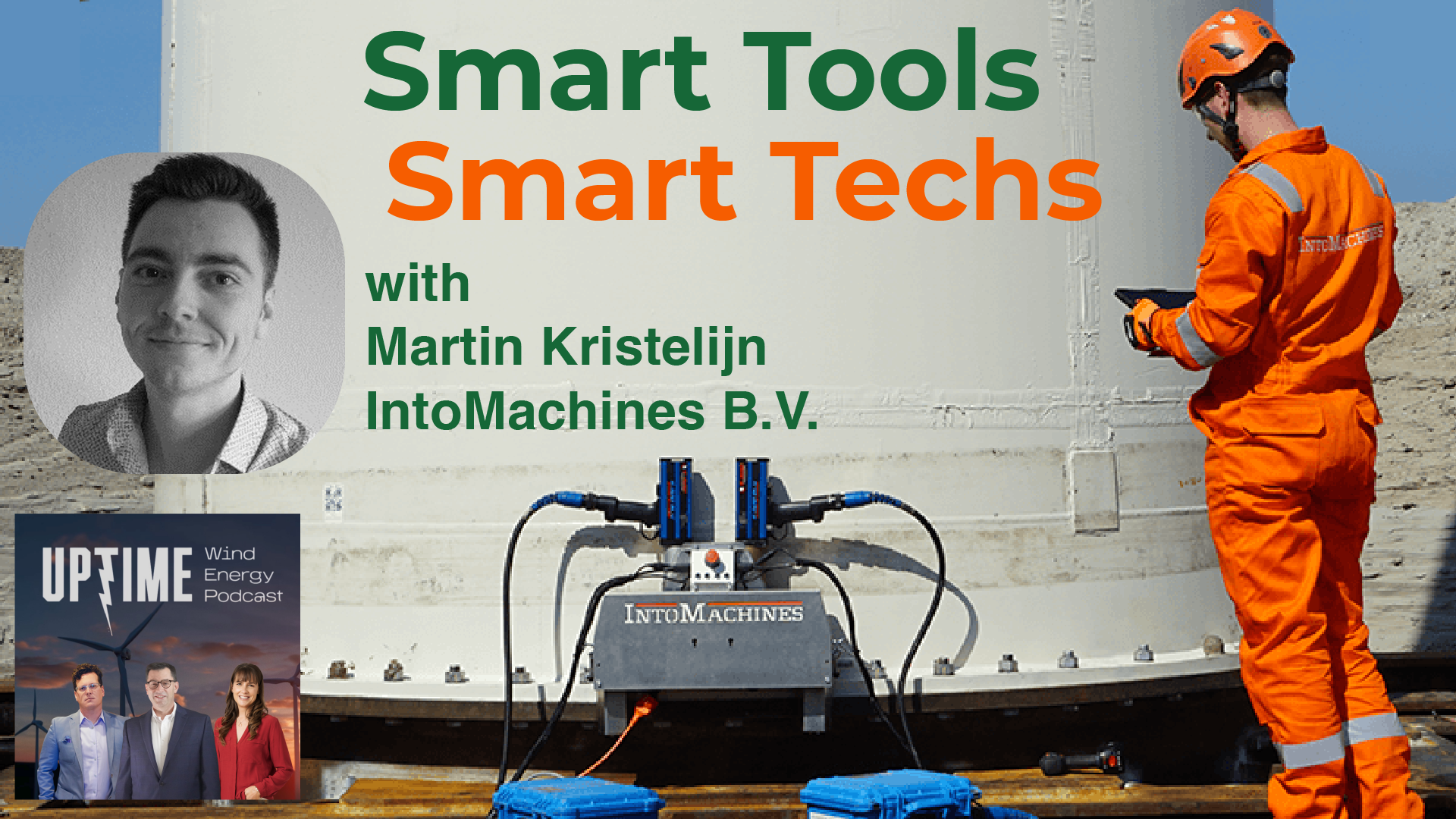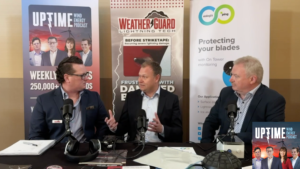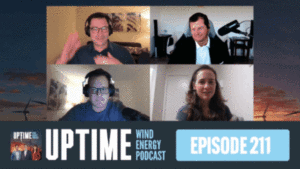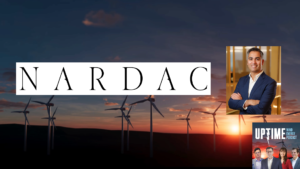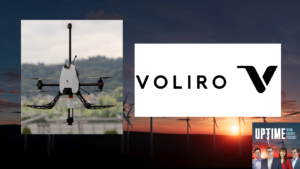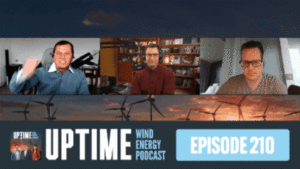We are thrilled to be speaking with Martin Kristelijn, the brilliant mind behind the game-changing technology company, IntoMachines. This innovative company has developed a range of cutting-edge products that are set to revolutionize the way wind turbine technicians work, starting with reducing the fatigue of technicians while working on bolted connections. From the torque tool trolley, which is set to make moving heavy equipment a thing of the past, to their advanced dual torque tool robot, IntoMachines is on a mission to make a significant impact on the lives of technicians worldwide.
Visit Pardalote Consulting at https://www.pardaloteconsulting.com
Wind Power Lab – https://windpowerlab.com
Weather Guard Lightning Tech – www.weatherguardwind.com
Intelstor – https://www.intelstor.com
IntoMachines – https://intomachines.com
Podcast: Play in new window | Download
Sign up now for Uptime Tech News, our weekly email update on all things wind technology. This episode is sponsored by Weather Guard Lightning Tech. Learn more about Weather Guard’s StrikeTape Wind Turbine LPS retrofit. Follow the show on Facebook, YouTube, Twitter, Linkedin and visit Weather Guard on the web. And subscribe to Rosemary Barnes’ YouTube channel here. Have a question we can answer on the show? Email us!
Bonus: IntoMachines
Allen Hall: Welcome to this bonus edition of the Uptime Wind Energy Podcast. I’m your host, Allen Hall, president of Weather Guard Lightning Tech. In today’s wind, turbines, as we all know, have several hundred bolts that are subjected to massive loads and stresses. Worldwide, there are more than 20 million wind turbine tower and foundation bolts.
That’s a lot. Keeping these bolts tightened is a monumental task, and as we know, technicians are in high. So in order to keep up, we need to provide technicians with the tools and resources to torque bolts faster and more reliably. That brings us to our guest, Martin Crystalin. Of Into Machines. Into Machines is a relatively new company based in the Netherlands, which focuses on making technicians more efficient with tools to make torquing easier.
Martin, welcome to the Uptime Win Energy Podcast.
Martin Kristelijn: Thank you very much for the invite. Very happy to be here.
Allen Hall: Well, as we know, as wind turbines have grown, there’s been more bolts and it takes longer to assemble and maintain those bolted connections. It’s a big problem, right? As we have seen, we’re just not able to keep up with the demand for technicians.
We’re kind of stuck right now on.
Martin Kristelijn: Yeah, it’s absolutely. We we saw this problem already three years ago. And our goal was to, to focus on optimizing the bolting procedure in wind turbines, both offshore and offshore. And we’re trying to do that for both both tensioning and both torquing.
And our solution is to provide very lightweight, easy to operate trolley solutions. As well as fully autonomous robots, which can help the operators in speeding up the process. And getting less fatigued by handling all the heavy bolting equipment in the towers.
Allen Hall: So that’s, that’s one of the issues Martin we’re seeing is as these equipment gets heavier and the bolts get bigger, it becomes more of an effort by a technician to actually tighten bolts.
And I, I, it sounds like we’re seeing some injuries from that. Is, are you hearing the same thing?
Martin Kristelijn: Yeah, exactly. We we talk a lot with technicians. So we go to wind turbines ourselves to try out a product. And yeah, the most hurt feedback we get is that the back starts to hurt after a couple of hours working with a tool weighing 40 kilograms or 50 or 60 even.
And that they like to have a trolley in order to help them lift the tool and transport it from one boat to the other. And yeah, we’re trying to, to provide those tooling to the technicians, to to make, make their lives much easier.
Allen Hall: Yeah. Because the issue right now, at least in the United States, and I think worldwide, is we’re gonna be putting in about a hundred thousand wind turbines over the next couple of years.
There is really no way to, to accomplish that goal without speeding up the process. We, we just won’t do it. And with the, I think in the United States, we’re gonna put about 3000 wind turbines offshore in the water, which is even a more difficult task in, in, in even bigger wind turbines. So there’s a real compounding problem happening at the moment.
Martin Kristelijn: Yeah, indeed. We we heard those numbers as well, and well we are from Europe actually based in the Netherlands. And so small detail. We we have also a lot of, of wind turbines, not as much as in the. But yeah, we see the problem indeed of having to install a lot of bolts and not having sufficient manpower and the manpower who is available.
Yeah, they start to fatigue as well due to the, the heavy work involved. So that is really the core problem we would like to solve. And that is speeding up the, the process. And by doing that, we also would like to lighten the work for the operator
Allen Hall: IntoMachines, has a couple of solutions. And I’ve, I’ve looked at your website, it’s very interesting and I, I want to touch on.
Really three of the offerings at the moment. The, the first one is probably the most simplest device, and it seems like the most ef effective most general use device, which is called the EAD 15 K Trolley. And it looks like a manual assistance lifting tool for your existing torque ranch. So can you describe that product for a minute?
Martin Kristelijn: What it consists of, It’s a steel frame. Having a gas spray. And the gas spraying lifts a standard tool in this case an electric tor tool of the brand. And the tool itself is around 50 kilograms, 40, 50 kilograms. And our trolley just grabs it with the standard clamp. So no adjustments to the tool itself.
The set up time is around one minute. So you take out the frame out of the case clamp it on the tool and off you. And the core principle it solves is that it makes it too weightless. So, yeah, you feel around 5% of the actual stool weight and you have to lift it a tiny bit, but then you can just drive around the flinch.
With a trolley
Allen Hall: So if, if that’s the case, if it makes a tool weightless, what kind of improvement are you getting in time to torque? Say a tower bolts like to do the 360 tower bolts. How much time are you saving with the trolley? Yeah, we
Martin Kristelijn: did several tests and also got some feedback from end customers.
And the, the same thing on the entire flan is around 30% time. And the, the funny thing is if you start so we did a test, one guy with a trolley and a torque tool and one guy manually transporting the, the the first 10 bolts are more or less the same. And so same speed same time shaving.
But if you then continue to the remaining 130. Then the guy doing it manually is completely fed up, eh, very heavy. And the guy who is running a trolley, well, he can go on the whole day because yeah, you’re just so much less fatigued in the whole process. So that helps a lot with speeding up the whole the whole bolting
Allen Hall: procedure.
And that trolley can be used on onshore and offshore wind turbines, correct? Yeah, exactly.
Martin Kristelijn: We modify the tiny bit for offshore, then it gets another coating that it is more durable. And yeah, we have that trolley for both torque tools and tensioning tools. So it’s brand independent and we can adapt it to almost any bolting tool available on the market at the moment.
Wow.
Allen Hall: Okay. That’s fascinating. So then, then you have a, like a second offering, which is a more automated system, which is called the A b M Autonomous. Bolting robot. There’s so many robots being used in wind energy today. This is a, a unique product. So this, if you’ve seen this one on LinkedIn or online, you, it’s, the videos kind of going viral at the moment.
It has two torque tools in a, in an automated trolley. And Martin, can you explain how that, how that tool
Martin Kristelijn: works? Yeah, yeah, definitely can. So in the mainly offshore environ, And the costs are very high. So you would like to install and torque or tension the bolts as quickly as possible, and especially in the US now with the feeder barge concept.
And that’s a concept where an installation vessel is waiting offshore and the floating barge all the sub-components to that vessel. Well on offshore, the installation vessel grabs the separate components from the feeder bar and especially the tower sections, they need to be bolted offshore together, and that is a lot of bolting time offshore.
So well our main goal was to make that bolting procedure more efficiently, efficiently, where the operators can insert the bolts in the f flang. You have to do that manually. That’s very difficult to automate. But once they are in, immediately afterwards our robot can follow and start to tension or torque the bolts.
Allen Hall: So at that, that sense, then you’re actually freeing up a technician. That’s a huge cost saver.
Martin Kristelijn: Yeah. Free up a technician. And the added benefit is that we can save up to 50% of offshore installation time. Because you can do almost two jobs at the same time, both inserting the bolts as well as tensioning the bolts.
At the same at the
Allen Hall: same time, the autonomous bolting robot has a little wrists keypad or, or touch screen so that the technician controls it sort of remotely. Can you explain how that wrist pad touchscreen
Martin Kristelijn: works? Yeah. We have a built-in a wireless. And that wireless module can communicate with any smart device.
So a smartphone or a smartwatch and this case in a video. And through that device you can insert some bolting parameters through the robot. And then start the robot procedure itself. Wow. So it looks really futuristic. It works very well, but our practice and experience also le learned us to insert a few manual buttons.
Because if you are wearing a big, heavy, greasy glove, then you would just like to press a button. So we have that option available as well. Very sturdy, very easy to to operate.
Allen Hall: Okay, that makes a lot of sense. I, I expect that robot to be used on offshore wind. Farms in the United States pretty soon because in order to speed up that process, they gonna need a robot to do that.
Now I wanna talk about tensioning for a minute, because you do make something called the Smart Tensioner which is another product to speed up technicians and help them finish this task. Can you explain what the smart tensioner is?
Martin Kristelijn: Yeah. So the the tensioning process happens that you have a tensioning tool and you need to threat that onto a.
For a stu that’s a piece of thread which sticks out above the nut. So you tread aome, apply hydraulic pressure. By that you elongate the nut and then you would like to tighten the nuts with a, a low torque such that the tension keeps in the stu. Then you release pressure and thread off the tensioner again.
Well, that treading on and rotating the. That is now done with a manual wrench, so you have to wrench it on and wrench it over again. And what we did is adding two electric motors one to tread on the bar onto the the thread and the other one to rotate the nuts. Automatically you have a, a very simple device with three push buttons.
One, two tread on de tensioner. One to initiate the process so it happens fully, automatically only press the button and a third button to thread off the tensioner again from the bolt. Well, and the, the beauty of it is that it is 30% faster compared to a manual operation of wrenching and rotating the.
Allen Hall: So as like on onshore wind farms have to go and check bolt tension, this would really speed up that process.
Martin Kristelijn: Yeah, absolutely. And especially on the the blade bolts, which at least in Europe, they are mostly tension bolts. They can now be re tensioned much quicker. And in addition to that, you get a, a nice overview with the bolting parameters of the applied pressure and not rotation and the bolt counts,
Allen Hall: for example, there is a number of software tools that come with your, your robots in your and your other tools.
It just going through your website, there are. Nice rec data recording and, and imaging software bits to produce a pdf d of, of how those bolts did. And just to keep track of how well your wind tur bolts are doing, I is that integrated into every tool that you have, even to the 15 K trolley? You could,
Martin Kristelijn: but at the moment the trolley is purely a mechanical device.
That means no software fault. We did that on purpose such that clients could start with that device and then build up their arsenal of our products if they like. So the, the bolt registration is definitely integrated in the smart tensioner and into our robotic devices as well. And that yeah, it just helps you that you the operator could not be mistaken in by accident.
Putting the wrong pressure on the hydraulic pump or the wrong torque in the the torque. And also that you have a bolt count. So skipping a bolt by accident, that cannot happen anymore cause the tool will tell you one is left. Okay.
Allen Hall: Well that’s, that’s really smart design. I, I like that. And just to, to touch on blade bolts for a minute, we’ve had a number of blade bolt issues here in the states.
It seems like that is one of the more significant alt tensioning problems cuz they are tension bolts. Do you need to really pay attention to those more than, say, a foundation
Martin Kristelijn: bolt? Yeah. It, it depends a bit on the wind turbine design. It has some some benefits and some disadvantages. So the, the bolts are a bit smaller and that makes it easier to, to pretension them.
Also the bolting tools are a bit lighter, but you have many of them and so you have three blade. And each blade, blade has a lot of bolts and therefore yeah, you would like to speed up the process of of tensioning or torquing those bolts. And yeah, with our smart tensioner that goes a lot quicker.
Allen Hall: Absolutely. Wow. Okay, so in order to use one of your tools, How do people get ahold of you? What does that process look like? What happens when they receive the tool? What’s the setup look like? Can you just walk through what that typical ordering delivery process looks like? Yeah, very
Martin Kristelijn: good. Question.
We have a website into machines.com and we have a, a small button, which is called request quote. You can fill in a very short form. Tell us which tool you would like or which setup you have. And then we come back to you within one day with for some additional questions on a specific setup or application or with a suggestion like this tool could fit your your application.
Well, if if that is all in order we can send out the products usually within a couple of weeks and yeah, we have a video with it. So how to use the, the tools, how to operate it. Usually it’s a 15 minute video. We explain what goes where, how it works, how to unpack it, and then off you go.
Allen Hall: So there’s no extra technician skillsets that are needed to, to use your products. It’s basically pull it outta the box, watch the video. Start using the tool? Is that how it goes? Yeah,
Martin Kristelijn: that is one of the focus points we did. We made that we tried to limit the amount of operated training in order to operate our tools.
So with a smart, we only have three buttons. With robot, we have a few more, but still very simple. And with the trolley, yeah, we have a couple of adjustments you can make to change it to varying flinch dimensions. But the bottom line is very simple and easy to
Allen Hall: operate. So then, If I’m assume that you have a number of these units out in the field and technicians are starting to use ’em, they must love these things because it makes life easier.
We’ve talked about 30 to upwards of 50% in terms of time saved. How the technicians enjoying the tool once they have it, I assume they think this thing is great. Yeah, so
Martin Kristelijn: the the technicians, they They work faster and so they could go home earlier at the end of the day potentially. And on the other hand, they also yeah, save their back and their wrists and all the other stuff which gets hurt during the bolting procedure.
And yeah. One additional thing is the fingers because pinching danger is still very up. Yeah, very accurate at the moment in in the wind. That the fingers can get pinched between tooling and the flinch and that can hurt really bad. So their safety is also improved much by by one of these
Allen Hall: products we offer.
Sure. And operators and service providers must love it because they get more done in a day and especially the United States where you have wind, wind farms that have a hundred machines plus there’s a lot of machines to take care of. Yeah, they’re quite,
Martin Kristelijn: quite big. Indeed. The. And the, the feedback we get is that yeah, the operation goes quicker and also on the safety aspect.
And the operators also like to to give their personnel safe equipment. So that is definitely a plus.
Allen Hall: Well, Martin, it’s been a pleasure having you on the program. I’m looking forward to seeing your IntoMachines, products at Wind, turman sites across the world. And if you’re interested in, in, into machines, check out IntoMachines at www.intomachines.com.
Martin, thanks for being on the program.
Martin Kristelijn: Absolutely. Thanks for having me. And yeah, looking forward to explaining the products we can offer.



